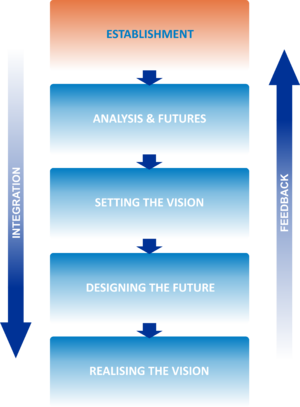The ICZM Process - a Roadmap towards Coastal Sustainability - Establishment
| Introduction |
|
Establishment |
|
Analysis and Futures |
|
Setting the Vision |
|
Designing the Future |
|
Realising the Vision |
|
Contents
The overall aim of this stage of the ICZM Process is to establish an operational foundation for the subsequent steps of the ICZM Process; to begin the process of understanding the challenges facing the coastal area and the differing perceptions of those challenges; and to begin building a constituency of support for the ICZM Process and for its expected outcomes.
It is not the intention and purpose of this stage to carry out a detailed scientific analysis of the state of the area or to fully uncover the complex interrelationships between issues. Rather, the purpose is to map the likely range of human and natural forces, the existing sectoral policies, and their potential interrelationships to be used as a trigger for the process and a focus for discussion, full analysis and identification of priorities in subsequent stages.
At this early stage effort should be directed to maximising the value of the Process as a tool for engaging stakeholders through good design,
non-technical language and appropriate visualised media.
Key tasks
- Establishing practical mechanisms for the ICZM Process, including coordination and cross-sectoral involvement of stakeholders, technical support to the Process, and communication among partners.
- Defining the territorial scope, by identifying the boundaries of the specific coastal zone and its ecosystems.
- Defining the governance context.
- Scoping the problems and issues, pressures and drivers, and risks.
- Engaging stakeholders and preparing communication strategy.
- Proposing a potential vision for the coastal area.
- Deciding on Strategic Environmental Assessment (SEA).
The key tasks are not necessarily performed in the order as outlined above. They can be run in parallel. The Work Plan defines timing for each task.
Potential Outputs
Depending on the type of initiative and its scale and magnitude, an Inception Report, including the Work Plan, and a Scoping Report may be needed. These may be combined into a single document.
Inception Report
The Inception Report should be agreed among the core partners in the ICZM Process to include:
- Background and purpose of the project including the "trigger” factors for the process (the trigger may be a political decision, a strategic priority or a response to a specific local problem or issue).
- The shared vision of working together.
- The larger macro, or high-level, elements of policy abstracted from the individual partners and the cross-cutting themes.
- The operational policy means of delivery, funding and consolidated actions.
- The geographical boundaries of the coastal area including both the terrestrial and marine boundaries.
- International and/or national context, including the relevant legal and strategic context and parameters of the process.
- The governing partnership and the proposed ICZM Coordination Structure, in the form of the ICZM Steering Group or Committee, including its objectives, tasks, mode of operation etc.
The Work Plan is a constituent part of the Inception Report. It should clearly detail the tasks and milestones of the Process, the allocation of responsibilities among partners, along with the logistical structure for technical and administrative support. The objective of the Work Plan is to help ensure the smooth running of the project and a common understanding of the time constraints, and to allocate resources efficiently over the planning period. Typically, the Work Plan should include:
- A detailed description of activities, with a wide range of practical, political and financial considerations presented.
- A basic time-line that should reflects elements of the ICZM Process.
- A simple GANTT chart that depicts graphically the order in which various stages of the ICZM Process should be completed to facilitate communication with partners and stakeholders. This should set out the duration of each phase, outputs and the key milestones. The GANTT chart should set out the following:
- ICZM Process stages;
- Major outputs;
- Key event dates;
- Critical milestones centred on key events;
- Key financial requirements;
- The schedule of implementation.
Scoping Report
The Scoping Report will contain the following:
- A preliminary assessment of the problems, issues, drivers, pressures and risks along with their relative importance, policy context and inter-relationships.
- Coastal governance baseline defining institutional, legal and policy context, as well as detailed analysis of the key stakeholders to identify their real competencies/roles, their capacity and importance/relevance for the Process. The ICZM Protocol specifies the range of stakeholders to be included in the Process: “...the territorial communities and public entities concerned; economic operators; non-governmental organizations; social actors; the public concerned.”
- A communication strategy.
- A potential vision for the area.
- Strategic Environmental Assessment (SEA), if so decided, which would be useful if an ICZM plan, strategy or programme is being prepared. The environmental authorities of the relevant state should therefore be consulted on the requirement for an SEA and its terms of reference.
Expert View
Marina Marcovic of PAP/RAC introduces the ICZM Process at the First Harmonisation Meeting for the transboundary integrated management of the Buna-Bojana river basin, coastal area and aquifers on the border of Albamia and Montenegro. July 2011.
Marina Markovic PAP/RAC
Go to next stage: Analysis and Futures
See Also
Please note that others may also have edited the contents of this article.
|


